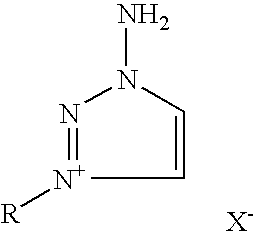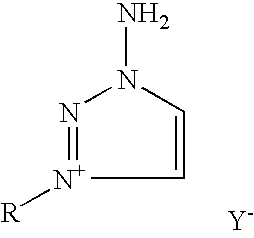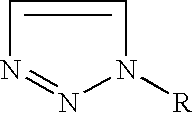Preparation of substituted-1,2,3-triazoles
a triazole and substitute technology, applied in the field of triazoles, can solve the problems of complex processes, complicated synthesis routes, and high cost of 1(h)-1,2,3-triazole, and achieve the effect of low cos
- Summary
- Abstract
- Description
- Claims
- Application Information
AI Technical Summary
Benefits of technology
Problems solved by technology
Method used
Image
Examples
example 1
Preparation of 1-amino-1,2,3-triazole (1)
[0041]In a 500 ml round bottomed flask, equipped with an over-head stirrer 14.46 g (168 mmoles) of glyoxal bishydrazone were dispersed in 225 ml of acetonitrile at 20° C. Manganese dioxide 30.00 g (348 mmoles), was added portion-wise over a few minutes to the vigorously stirred solution. The reaction was stirred for 40 minutes whereupon additional manganese dioxide 20.00 g (232 mmoles) was added. Thin layer chromatography revealed the reaction was complete 20 minutes later and it was filtered through a plug of Celite. The filtrate was stripped down under reduced pressure leaving a viscous oil, that was sublimed yielding 12.30 g (88%) of highly pure 1-amino-1,2,3-triazole (1), mp 49-50° C.
example 2
Preparation of 1-amino-3-methyl-1,2,3-triazolium iodide (2a)
[0042]In a 100 ml flask, equipped with a magnetic stirrer, 2.00 g (23.8 mmoles) of 1-amino-1,2,3-triazole (1) was dissolved and stirred vigorously in 40 ml of acetonitrile at 20° C., whereupon methyl iodide 22.92 g (161.9 mmoles) was added. The reaction was stirred in darkness, being periodically monitored by thin layer chromatography until all 1-amino-1,2,3-triazole (1) was consumed. As the reaction progressed, white crystals of 1-amino-3-methyl-1,2,3-triazolium iodide (2a) precipitated. The product salt was filtered and washed with several aliquots (50 ml total) of diethyl ether. The mother liquor was concentrated by distillation under reduced pressure resulting in a second crop of crystals that were filtered, washed with diethyl ether combined with first crop and dried under high vacuum, resulting in a good yield of 4.99 g (93%) of 1-amino-3-methyl-1,2,3-triazolium iodide (2a), mp 146° C.
example 3
Preparation of 1-amino-3-ethyl-1,2,3-triazolium bromide (2b)
[0043]In a 100 ml glass reactor, equipped with a magnetic stirrer was placed 2.00 g (3.8 mmoles) of 1-amino-1,2,3-triazole (1) and dissolved in 40 ml of acetonitrile. To the reaction mixture was added 12.05 g (110.5 mmoles) of ethyl bromide and the reactor was sealed. The reaction mixture was stirred vigorously at 45° C. until all 1-amino-1,2,3-triazole was consumed. As the reaction progressed, white crystals of 1-amino-3-ethyl-1,2,3-triazolium bromide (2b) precipitated. The reaction mixture was cooled down to room temperature. The product salt was filtered and washed with several aliquots (50 ml total) of diethyl ether. The mother liquor was concentrated by distillation under reduced pressure, resulting in a second crop of crystals that were filtered, washed with diethyl ether, combined with the first crop and dried under high vacuum, resulting in a good yield of 3.82 g (83%) of 1-amino-3-ethyl-1,2,3-triazoliumbromide (2b)...
PUM
| Property | Measurement | Unit |
|---|---|---|
| temperatures | aaaaa | aaaaa |
| temperature | aaaaa | aaaaa |
| melting | aaaaa | aaaaa |
Abstract
Description
Claims
Application Information
 Login to View More
Login to View More - R&D
- Intellectual Property
- Life Sciences
- Materials
- Tech Scout
- Unparalleled Data Quality
- Higher Quality Content
- 60% Fewer Hallucinations
Browse by: Latest US Patents, China's latest patents, Technical Efficacy Thesaurus, Application Domain, Technology Topic, Popular Technical Reports.
© 2025 PatSnap. All rights reserved.Legal|Privacy policy|Modern Slavery Act Transparency Statement|Sitemap|About US| Contact US: help@patsnap.com



